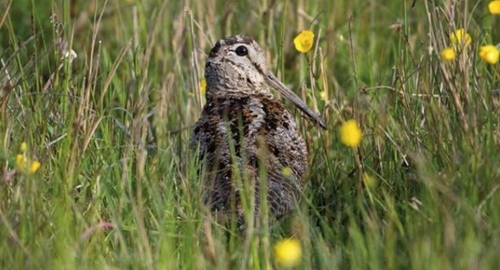
As you may already be aware, 2023 is an important year for woodcock research. For the third time since its inception in 2003, GWCT and BTO are running the national Breeding Woodcock Survey to provide a snapshot of our resident woodcock population’s size and status. The survey relies on a carefully calibrated survey method, and an army of volunteer surveyors across the country. Taking part is relatively simple, and we encourage anyone with an interest in woodcock to get involved!
- Visit the Breeding Woodcock Survey webpage, hosted by our BTO collaborators: www.bto.org/woodcock . Here, you can find a map showing the locations of randomly selected survey squares*. If there’s an available site you wish to survey, you can register for a BTO account and sign-up for your chosen square. If there’s no survey squares near you, please check back in a few weeks’ time, as a second batch of squares will be released once uptake crosses a particular threshold.
- Make a recce visit to your chosen square in April to find a suitable count point. A count point could be a large clearing within a wood or the intersection of two woodland rides, from which you can count roding woodcock. If possible, it’s best to count within the largest patch of woodland within the chosen square. Try to make your recce visit at dusk, as it may provide the opportunity to see roding woodcock and get familiar with their call.
- Make your first survey visit in early- to mid-May. Survey visits begin 15 minutes before sunset and last 75 minutes in total. This is the period in which male woodcock perform their roding displays – watch for slow-flying woodcock, travelling at treetop height, and repeating a ‘whistle-and-grunt’ call. Note down every separate woodcock registration (woodcock seen or heard, inc. non-roding birds) and the time they were encountered. There is a recording form on the BTO website to help with this. On the first visit, we also ask volunteers to record some very simple data regarding the appearance of surrounding woodland (again, a survey form is provided on the website).
- Repeat the survey in late-May or early-June. If you record woodcock on either of your first two visits, we also recommend you make a third visit in late June. If you do not record woodcock, two visits are sufficient.
- Enter your data. Log into the BTO website and enter the data using a simple online form. Please try to enter your data as promptly as possible. It’s important that you enter any data you gather, even if you didn’t see any woodcock! Zero counts are just as valuable as positive counts.
- The rest is up to us. We’ll use your counts to estimate how many males were present at your survey site. We’ll use counts from neighbouring squares to estimate average woodcock densities in your region. From this, we’ll scale up, to estimate the population size for your region, and then by combining all regions, a national total. This method is the same as 2003 and 2013, so we can compare to earlier surveys to assess population change. The totals for individual sites will be kept confidential – the results are only every published as regional and national totals.
*Why random squares? We know this might seem strange, especially as some of the randomly selected squares fall in areas where it is unlikely that woodcock will be found. But this randomness is important. We want to avoid biasing our survey towards just the sites where woodcock remain abundant. Instead, we need to gather data from a representative sample of squares to ensure our national assessment accurately reflects the UK as a whole. This randomness does mean that, in some areas, squares are only sparsely available or remote. If there are no squares near you please get in touch with us and we may be able to offer a more convenient option (woodcock@gwct.org.uk).